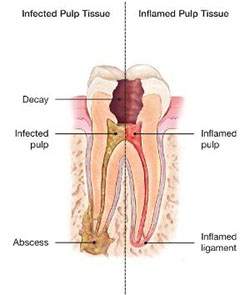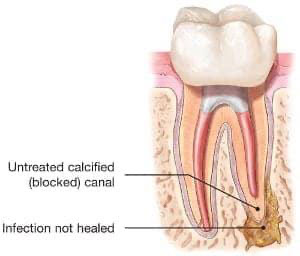Root canal treatment
Endodontic treatment is necessary when the pulp, the soft tissue inside the root canal, becomes inflamed or infected. The inflammation or infection can have a variety of causes: deep decay repeated dental procedures on the tooth or a crack or chip in the tooth. In addition, an injury to a tooth may cause pulp damage even if the tooth has no visible chips or cracks. If pulp inflammation or infection is left untreated, it can cause pain or lead to an abscess.
Root canal treatment is designed to eliminate bacteria from the infected root canal, prevent reinfection of the tooth and save the natural tooth. When one undergoes a root canal, the inflamed or infected pulp is removed and the inside of the tooth is carefully cleaned and disinfected, then filled and sealed.

Endodontic Retreatment
As occasionally happens with any dental or medical procedure, a tooth may not heal as expected after initial treatment for a variety of reasons:
- Complicated canal anatomy went undetected in the first procedure.
- The placement of the crown or other restoration was delayed following the endodontic treatment.
- The restoration did not prevent salivary contamination.
In other cases, a new problem can jeopardize a tooth that was successfully treated. For example: New decay can expose the root canal filling material to bacteria, causing a new infection in the tooth.
The goal of the retreatment is: To remove previous root canal filling materials from the tooth, followed by cleaning, shaping, and obturating the canals.

Endodontic surgery (Apico)
Usually, a tooth that has undergone a root canal can last the rest of your life and never need further endodontic treatment. However, in a few cases, a tooth may not heal or become infected. A tooth may become painful or diseased months or even years after successful treatment. If this is true for you, surgery may help save your tooth.
Surgery may also be performed to treat damaged root surfaces or surrounding bone. In this procedure, the endodontist opens the gum tissue near the tooth to see the underlying bone and to remove any inflamed or infected tissue. The very end of the root is also removed.
.jpg?crc=3954486956)
POST AND CORE
Most often, this procedure is used after a tooth has had a root canal and is in need of a crown.
Core Buildup. (When a Tooth Does Not Need a Post) A Core Buildup is used when a fracture or decay causes a portion of a tooth to break off, and in some cases, there's simply not enough tooth left to place a crown.
Only with the proper core buildup can the treated tooth be adequately sealed against further infection
.jpg?crc=65154509)
CBCT in Endodontics
Cone beam computed tomography is an innovative medical imaging technique that provides endodontists with three-dimensional views of the patient. In certain cases, CBCT greatly enhances the endodontist's ability to diagnose, evaluate, treat and care for patients.
Perhaps the most important advantage of CBCT in endodontics is that it demonstrates anatomic features in 3D that intraoral, panoramic, and cephalometric images cannot. CBCT units reconstruct the projection data to provide interrelational images in three orthogonal planes (axial, sagittal, and coronal).
Excellence in quality and comfort
Get Social

At Premier Endodontics our goal is to provide excellent root canal treatment ensuring your comfort at all times. We use the most advanced technology available delivered by a highly qualified and experienced endodontist.
Contact us
3400 N. McColl Rd. Suite C
McAllen, TX. 78501
956.800.4002
ar@premierendodds.com
© 2020 Premier Endodontics, P.C.
